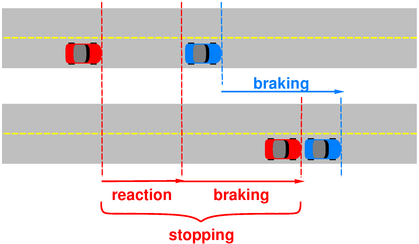
When a driver hits the brakes, the car does not stop immediately. The forward motion, weight of the vehicle, and traveling speed determine how quickly the car stops. There are formulas to calculate how far a car will travel before it comes to a stop. These charts can give an approximation of how long it will take to stop a vehicle, depending on speed and road conditions. Other factors, such as reaction time, vehicle weight, and quality and maintenance of the car, vary, which is why these figures are only approximations.
|
Stopping Distances for Automobiles on Dry Pavement |
|||
|
Speed |
Driver Reaction Time |
Braking Distance |
Overall Stopping Distance |
|
32 km/h (20 mph) |
6.7 m (22 ft) |
6.4 m (21 ft) |
13 m (43 ft) |
|
48 km/h (30 mph) |
10 m (33 ft) |
14 m (47 ft) |
24 (80 ft) |
|
64 km/h (40 mph) |
13.5 m (44 ft) |
25 m (82 ft) |
38 m (126 ft) |
|
80.5 km/h (50 mph) |
17 m (55 ft) |
39 m (128 ft) |
56 m (183 ft) |
|
96.5 km/h (60 mph) |
20 m (66 ft) |
56 m (185 ft) |
76 m (251 ft) |
|
112.5 km/h (70 mph) |
23.5 m (77 ft) |
77 m (252 ft) |
100 m (329 ft) |
|
129 km/h (80 mph) |
27 m (88 ft) |
100 m (328 ft) |
127 m (416 ft) |


